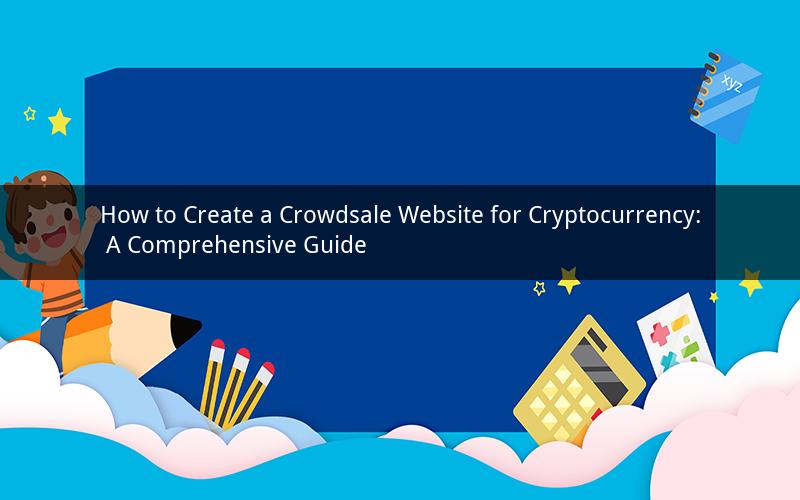
Creating a crowdsale website for cryptocurrency can be a challenging yet rewarding endeavor. With the increasing popularity of digital currencies, more and more startups and projects are looking to raise funds through crowdsales. This guide will provide you with a comprehensive overview of the steps involved in creating a successful crowdsale website for cryptocurrency.
1. Understanding Crowdsales and Cryptocurrency
Before diving into the technical aspects of building a crowdsale website, it's crucial to have a clear understanding of what a crowdsale is and how it relates to cryptocurrency.
A crowdsale is a fundraising method where a company or project offers digital tokens or coins to the public in exchange for cryptocurrency, usually Bitcoin or Ethereum. It is similar to an initial public offering (IPO) but is specific to the crypto world. The funds raised through a crowdsale are used to finance the project or business.
Cryptocurrency, on the other hand, is a digital or virtual form of currency that uses cryptography to secure transactions, control the creation of new units, and verify the transfer of assets. The most popular cryptocurrency is Bitcoin, but there are thousands of other cryptocurrencies, such as Ethereum, Litecoin, and Ripple.
2. Planning Your Crowdsale Website
Once you have a clear understanding of crowdsales and cryptocurrency, it's time to plan your crowdsale website. Here are some key aspects to consider:
a. Define Your Project: Clearly articulate the purpose and goals of your project. This will help potential investors understand what you're trying to achieve and why they should invest in your project.
b. Tokenomics: Develop a comprehensive tokenomics model that outlines the total supply of tokens, distribution schedule, and usage of tokens. This will help investors understand how the tokens will be utilized and how they can benefit from holding them.
c. Legal and Compliance: Ensure that your crowdsale complies with the relevant regulations and laws in the jurisdictions where you plan to conduct the sale. This may involve obtaining licenses, registering with financial authorities, and adhering to anti-money laundering (AML) and know your customer (KYC) requirements.
d. Marketing and Promotion: Create a marketing plan to promote your crowdsale website and attract potential investors. This may include social media campaigns, partnerships with influencers, and attending crypto conferences and events.
3. Choosing the Right Technology
Selecting the appropriate technology is crucial for the success of your crowdsale website. Here are some key factors to consider:
a. Blockchain Platform: Choose a blockchain platform that aligns with your project's needs. Ethereum is the most popular platform for crowdsales due to its smart contract capabilities, but other platforms like Binance Smart Chain, Cardano, and Polkadot may offer alternative solutions.
b. Crowdsale Platform: There are various crowdsale platforms available that can help you create and manage your crowdsale website. Some popular options include OpenZeppelin, TokenGen, and ICOBox.
c. Web Development: Hire skilled web developers to design and develop your crowdsale website. Ensure that the website is user-friendly, mobile-responsive, and secure.
4. Building the Crowdsale Website
Once you have a clear plan and the necessary technology in place, it's time to build your crowdsale website. Here are the key components:
a. Home Page: The home page should provide an overview of your project, including its purpose, tokenomics, and team members. It should also include a countdown timer for the crowdsale start date.
b. Whitepaper: Provide a comprehensive whitepaper that outlines your project's vision, technology, and use case. This will help investors understand the potential of your project.
c. Token Sale Page: This page should detail the crowdsale process, including the token price, available tokens, and payment methods. It should also include a token calculator to help investors estimate the number of tokens they can purchase.
d. KYC/AML Compliance: Implement a KYC/AML compliance system to ensure that all participants in the crowdsale adhere to legal requirements.
e. FAQ Section: Create a Frequently Asked Questions (FAQ) section to address common concerns and questions from potential investors.
5. Launching the Crowdsale Website
After building your crowdsale website, it's time to launch it. Here are some tips for a successful launch:
a. Pre-Launch Marketing: Begin promoting your crowdsale website weeks or months before the launch. This will help generate buzz and attract potential investors.
b. Community Engagement: Engage with your community through social media, forums, and other channels. This will help build trust and encourage participation in the crowdsale.
c. Launch Event: Host a virtual launch event to officially announce the start of your crowdsale. This can include presentations, interviews, and live Q&A sessions with your team.
6. Post-Launch Activities
Once your crowdsale has ended, there are several post-launch activities you should focus on:
a. Project Development: Use the funds raised from the crowdsale to develop your project. Keep your community updated on progress through regular updates and milestones.
b. Token Distribution: Ensure that tokens are distributed to investors as per the agreed-upon schedule and terms.
c. Marketing and Community Engagement: Continue marketing and engaging with your community to maintain interest and support for your project.
7. Conclusion
Creating a crowdsale website for cryptocurrency requires careful planning, technology selection, and execution. By following this comprehensive guide, you can increase your chances of a successful crowdsale and help your project reach its goals. Remember to stay compliant with legal requirements, engage with your community, and focus on delivering value to your investors.
Questions:
1. What are the key considerations when choosing a blockchain platform for a crowdsale website?
2. How can you ensure that your crowdsale website is secure and user-friendly?
3. What are the main components of a successful crowdsale website?
4. How can you effectively market your crowdsale website to attract potential investors?
5. What are some post-launch activities that can help maintain interest in your project?